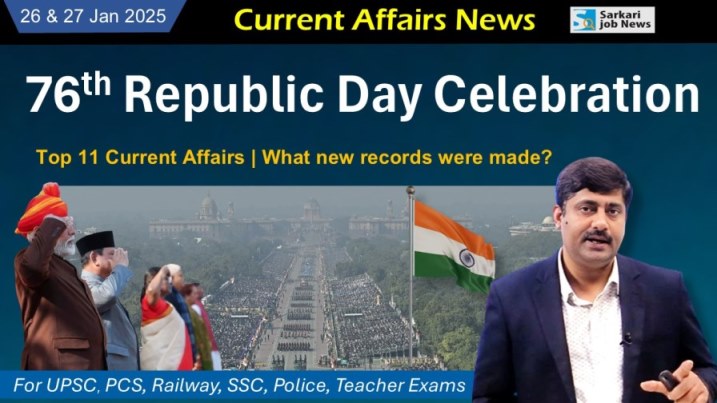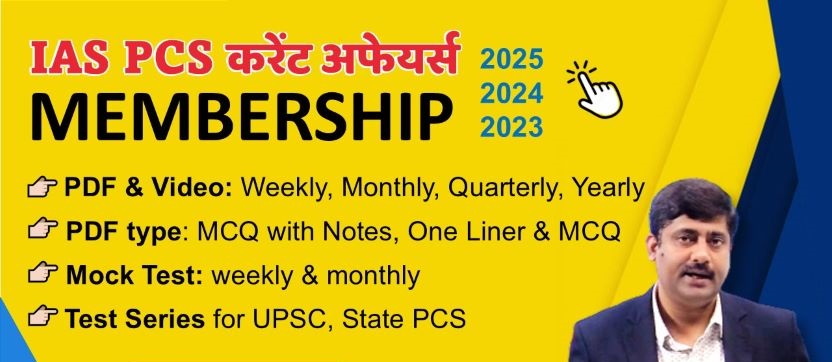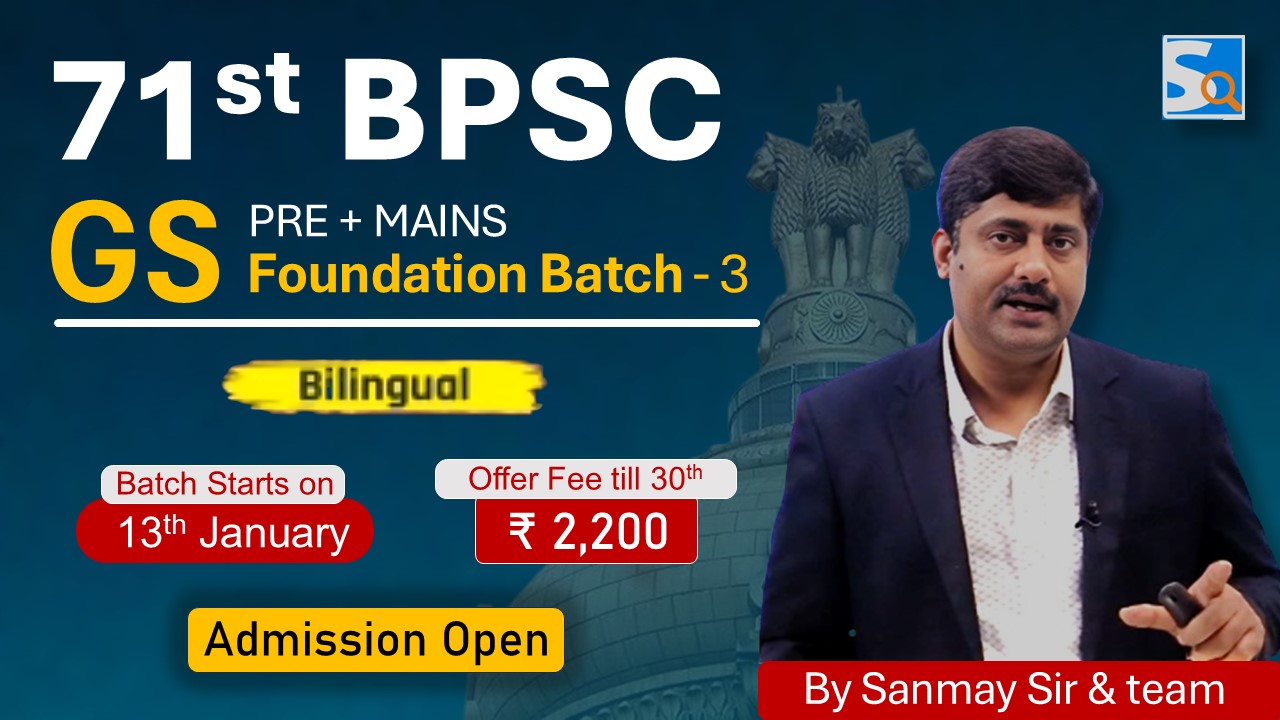This is the current affairs of 26 & 27 January 2025. Here are questions and answers of daily current affairs for better preparation of competitive exams for government jobs.
PDF Download: Click here
1. On January 26, 2025, which Republic Day was celebrated?
a. 74th
b. 75th
c. 76th
d. 77th
Answer: c. 76th
– The Constitution of India came into effect on January 26, 1950.
– On this date, India became a Republic, and the first Republic Day was celebrated on January 26, 1950.
– In 2025, the 76th Republic Day was celebrated.
– The main ceremony took place at Kartavya Path, where President Droupadi Murmu hoisted the tricolor.
Meaning of Republic
– It is a form of government where power is held by the people or their elected representatives.
– In a Republic, the President or Prime Minister and other leaders are chosen by the people, and there is no monarchy. Modern republics are based on the idea that sovereignty belongs to the people.
– This day marks the anniversary of India officially adopting its Constitution and becoming a sovereign republic.
————–
2. What is the theme of 76th Republic Day celebration (26 January 2025)?
a. ‘Developed India’ and ‘India: Mother of Democracy’
b. ‘Developed India’ and ‘India: World’s First Republic’
c. Republic India: Mother of Democracy
d. ‘Golden India: Heritage and Development’
Answer: d. ‘Golden India: Heritage and Development’
(‘Swarnim Bharat: Virasat aur Vikas’)
Note – The theme of the next year (2024) – ‘Developed India’ and ‘India: Mother of Democracy’
—————
3. Who was the chief guest at the 76th Republic Day celebration?
a. Vladimir Putin
b. Prabowo Subianto
c. Joe Biden
d. Emmanuel Macron
Answer: b. Prabowo Subianto (President of Indonesia)
– Subianto’s visit marked his first state visit to India.
– He became the fourth Indonesian President to be the Chief Guest at the 2025 Republic Day celebrations.
Instances when Indonesian leaders were Chief Guests:
1. 1950: Sukarno (First President of Indonesia)
2. 2011: Susilo Bambang Yudhoyono (Then President)
3. 2018: Joko Widodo (Then President) [Accompanied by leaders of 10 ASEAN countries]
4. 2025: Prabowo Subianto (President of Indonesia)
Recent Republic Day Chief Guests:
– 2025: Prabowo Subianto, President of Indonesia
– 2024: Emmanuel Macron, President of France
– 2023: Abdel Fattah el-Sisi, President of Egypt
– 2021 / 2022: No Chief Guest (Reason: COVID-19 pandemic)
– 2020: Jair Bolsonaro, President of Brazil
– 2019: Cyril Ramaphosa, President of South Africa
– 2018: Leaders of all 10 ASEAN countries, including Joko Widodo
– 2017: Sheikh Mohammed bin Zayed Al Nahyan, UAE President
– 2016: François Hollande, Then President of France
– 2015: Barack Obama, Then President of the United States
Indonesia:
– Capital: Jakarta
– Proposed Capital: Nusantara
– President: Prabowo Subianto
– Currency: Indonesian Rupiah
————–
4. Which of the following did the Indian President and Indonesian President ride on to the Kartavya Path during the 76th Republic Day Parade ceremony?
a. Historical horse drawn carriage
b. Historical camel drawn carriage
c. A beautiful bullock cart
d. High security car
Answer: a. Historical horse drawn carriage
– During the 75th Republic Day in 2024, the historic state carriage (bagghi) was used after 40 years, having last been part of the celebrations in 1984.
– On the 76th Republic Day (January 26, 2025), President Droupadi Murmu arrived at Kartavya Path in the traditional state carriage, starting her journey from Rashtrapati Bhavan.
– Indonesian President Prabowo Subianto, the Chief Guest for the 2025 celebration, also rode in the same carriage.
– The state carriage had not been used in Republic Day celebrations since 1984, when it was replaced by a high-security vehicle following the assassination of then-Prime Minister Indira Gandhi.
– However, in 2014, the state carriage was reintroduced for the Beating Retreat Ceremony by then-President Pranab Mukherjee. Successive presidents, including Ram Nath Kovind, continued this tradition.
– In 2024, the state carriage made its return to the main Republic Day celebration. President Murmu, alongside French President Emmanuel Macron, rode the carriage to Kartavya Path.
About the State Carriage (Bagghi):
– After India gained independence, the state carriage was awarded to India through a coin toss with Pakistan.
– This gold-plated, horse-drawn carriage originally belonged to the Viceroy of British India during the colonial era.
– In 1947, after independence, the Governor-General’s Bodyguard unit (now known as the President’s Bodyguard) was divided between India and Pakistan in a 2:1 ratio.
– When it came to dividing the Viceroy’s carriage, both nations claimed it.
– The matter was resolved through a coin toss between Lieutenant Colonel Thakur Govind Singh (India) and Sahabzada Yaqub Khan (Pakistan), with India emerging victorious.
– Thus, the state carriage became a part of India’s presidential tradition.
————–
5. Which foreign army also took part in the parade on the ‘Kartavya Path’ in the 76th Republic Day celebrations?
a. Bangladesh
b. Indonesia
c. France
d. Germany
Answer: b. Indonesia
– The parade featured a marching contingent and music band from the Indonesian Army.
– The band was named Gendrang Suling Kanka Lokananta.
————–
6. In which areas several agreements were signed between the two countries during the visit of Indonesian President to India on Republic Day?
a. Culture, Health
b. Health, Marine
d. Security
d. All of the above
Answer: d. All of the above
– Indonesia and India signed a number of agreements covering culture, health, maritime, security and digital sectors on 25 January 2025.
– President Prabowo said his government will accelerate its economic partnership with India and prioritise long-term cooperation.
– Ahead of Prabowo’s speech, Prime Minister Modi said the two countries will work together to improve defence manufacturing and supply chains.
India-Indonesia Relations
Ups and downs in the relationship between India and Indonesia
– In the 75 years since Sukarno and Prabowo Subianto took turns as chief guests at Republic Day celebrations, the relationship between the two countries has seen its ups and downs.
Nehru helped Indonesia win independence
– Relations between the two countries improved rapidly in the late 1940s over a shared commitment to anti-imperialism and shared democratic principles.
– Indonesia declared independence in 1945, but the Dutch (Netherlands) formally recognised the country’s sovereignty only in 1949.
– Jawaharlal Nehru was one of the leading global politicians in support of Indonesian independence.
– After taking charge of the interim government in 1946, Nehru said in a radio broadcast that “the fundamental objective of India’s foreign policy must be the abolition of colonialism throughout Asia” and that he would “help and support” Indonesian nationalists “in every possible way.”
– As well as sending supplies and humanitarian aid to the nationalist rebels, Nehru banned Dutch airlines from flying over India in 1947.
– In July 1947, Nehru sent a young Biju Patnaik to Jakarta to evacuate Indonesia’s Prime Minister Sutan Sjahrir and Vice President Mohammad Hatta.
– Patnaik dodged Dutch anti-aircraft fire and flew the two to New Delhi, from where they headed west to represent Indonesia’s side at international forums.
– After the Dutch formally recognised Indonesia’s independence in December 1949, Indonesia’s first President Sukarno was naturally grateful for India’s support. He even wrote an article about it in ‘The Hindu’ newspaper.
– Subsequently, Indonesia’s first President Sukarno was invited to India’s first Republic Day celebrations in 1950.
Relations deteriorated as Indonesia moved closer to China and Pakistan
– Relations between the two countries deteriorated in the 1960s as Indonesia grew closer to China and Pakistan.
– When China invaded India in 1962, Indonesia showed little sympathy – let alone solidarity – with its fellow non-aligned countries.
– And as relations with India deteriorated, Indonesia moved closer to Pakistan.
– Sukarno visited Pakistan several times in 1963-64 as Jakarta gradually abandoned its neutrality on the Kashmir issue.
– Relations deteriorated so much that when war broke out between India and Pakistan in September 1965, Indonesia’s foreign minister Subandrio declared: “All countries allied to the newly emerging powers have an obligation to assist Pakistan in countering the Indian aggression.” During the war, Indonesia not only supplied arms to Islamabad but its leaders also fanned anti-Indian sentiments among Indonesians, culminating in a mob attack on the Indian embassy in Jakarta.
– By then, however, President Sukarno’s position in Indonesia had begun to deteriorate.
Indonesia distanced itself from China and grew ties with India
– Domestically, Sukarno had long maintained a shaky balance of power between the military, the Communists, and himself.
– A leftist coup attempt in 1965 changed things.
– The military responded brutally, and the Communists were nearly wiped out. This weakened Sukarno, and by 1966 he effectively handed all power to General Suharto, a staunch anti-communist. General Suharto had the support of the United States.
– The incident effectively broke the alliance between China and Indonesia.
– Suharto then immediately began working towards repairing many of the relationships that had been damaged by the Sukarno regime, including relations with India. India responded positively, and several trade agreements were signed in 1967.
‘Look East’ and beyond
– Real progress in relations was made only in the 1990s, when the P.V. Narasimha Rao government launched the ‘Look East’ policy.
– The Soviet Union was history by then, so India had to find new friends as quickly as possible.
– When India moved towards economic liberalisation in 1991, there was an opportunity to pursue trade and economic cooperation like never before.
– Under these circumstances, the ‘Look East’ policy was born, aimed at strengthening India’s relations with the South-East Asian countries, which were emerging as one of the fastest growing economies in the world at the time.
– In 2014, the Narendra Modi government took things to the next level by launching the more project- and result-oriented ‘Act East’ policy.
India – Economic Relations in Indonesia
– Indonesia is today India’s second-largest trading partner in the ASEAN region (after Singapore).
– Bilateral trade is projected to grow from $4.3 billion in 2005-06 to $38.84 billion in 2022-23 and $29.40 billion in 2023-24.
– What India imports: Coal, crude palm oil, minerals, rubber, pulp and paper, and hydrocarbons. (India is the second-largest buyer of coal and the largest buyer of crude palm oil from Indonesia.)
– What India exports: Refined petroleum products, commercial vehicles, telecommunication equipment, agricultural commodities, bovine meat, steel products and plastics, etc.
– However, experts say there is still a lot of scope to further improve the relationship. Despite India’s Act East policy and the importance India attaches to the Indo-Pacific, India’s partnership with Indonesia remains far below its potential.
Indonesia is the 10th member of BRICS
– During his visit to India, Prabowo Subianto thanked India for its support to Indonesia in its bid to become a BRICS member and said the group of emerging market economies would “be beneficial to global stability and regional cooperation.”
—————-
7. Which missile was demonstrated ‘for the first time’ on the 76th Republic Day?
a. Brahmos missile
b. Pralay missile
c. Tiger Cat missile
d. Akash missile
Answer: b. Pralay missile
#Missile Systems Displayed at Republic Day Parade This Year#
1. BrahMos Supersonic Cruise Missile
– This is a supersonic cruise missile.
– It can be launched from submarines, ships, aircraft, or the ground.
– The missile has been inducted into the Indian Army, Navy, and Air Force.
– The name BrahMos is derived by combining the names of the Brahmaputra River in India and the Moskva River in Russia.
– When launched from the ground or sea, BrahMos can destroy its target at a speed of Mach 2 to 3 (2500 km/h) within a range of 290 kilometers.
– BrahMos can be launched from a submarine at a depth of 40-50 meters underwater. The test of launching BrahMos from a submarine was conducted in 2013.
2. Pinaka Multi-Barrel Rocket Launcher (MBRL) System
– The range of Pinaka MK1 is 38 kilometers. – It can fire various types of ammunition.
– Work is underway to increase its range, with plans to extend it to over 75 kilometers.
– Eventually, the goal is to increase the range to 120 kilometers and then 300 kilometers.
– The name Pinaka refers to the bow of the Hindu god Shiva.
– It was developed by DRDO in 1986, and since then, several advanced versions have been released.
– Its production is handled by Tata Advanced Systems and Larsen & Toubro (L&T).
3. BM-21 Grad
– The BM-21 Grad is a self-propelled 122mm multiple rocket launcher designed in the Soviet Union.
– The system and the M-21OF rocket were first developed in the early 1960s.
4. Pralay Semi-Ballistic Missile System
– This is a surface-to-surface (SRBM) short-range ballistic missile. – It has been developed by the Defence Research and Development Organisation (DRDO). – ‘Pralay’ is a short-range missile with a range of 350-500 km. – It has a payload capacity of 500-1,000 kg. – ‘Pralay’ was developed for deployment along the Line of Actual Control (LAC) and Line of Control (LOC).
Note: The Defence Research and Development Organisation (DRDO) also displayed a model of the indigenous Advanced Towed Artillery Gun System (ATAGS) in its tableau.
Additionally, 40 aircraft participated in the Air Force flypast, including 22 fighter jets, 11 transport aircraft, and 7 helicopters. Apache, Rafale, and Globemaster were part of this flypast.
—————-
8. On the 76th Republic Day, a joint tableau of the tri-service was displayed for the first time, what was its theme?
a. ‘Golden India: Heritage and Development’
b. ‘Strong and Secure India’
c. ‘Developed and Secure India’
d. ‘Golden Age of India’
Answer: b. ‘Strong and Secure India’
– A joint operations room, facilitating communication and coordination between the Army, Navy, and Air Force, was showcased.
– This tableau reflects the overarching spirit of synergy among the armed forces.
– The Republic Day Parade 2025 demonstrated coordinated operations across land, sea, and air.
– The display featured indigenous Arjun battle tanks, Tejas MK II fighter jets, Advanced Light Helicopters, the destroyer ship INS Visakhapatnam, and a remotely operated aircraft, symbolizing the coordination of the three services in multi-domain operations.
—————
9. Tableau of how many states, union territories and ministries took part on the Path of Duty in the 76th Republic Day celebrations?
a. 15 States and UT and 16 Ministries
b. 26 States and UT and 9 Ministries
c. 6 States and UT and 19 Ministries
d. 16 States and UT and 9 Ministries
Answer: a. 15 States and UT and 16 Ministries
– On the 76th Republic Day, tableaux from 15 states/union territories and 16 ministries were displayed on Kartavya Path.
– For the first time, 5,000 artists performed together on Kartavya Path.
– Madhya Pradesh’s tableau showcased the cheetahs of Kuno National Park.
– Uttar Pradesh’s tableau was based on the Mahakumbh 2025.
—————
10. When is International Customs Day observed?
a. 23 January
b. 24 January
c. 25 January
d. 26 January
Answer: d. 26 January
– International Customs Day is celebrated every year on January 26.
– It is observed to honor the role of customs officers and agencies.
– The day was first introduced in 1953 by the World Customs Organization.
—————
11. When is International Holocaust Remembrance Day observed?
a. 25 January
b. 27 January
c. 29 January
d. 31 January
Answer: b. 27 January
– International Holocaust Remembrance Day is observed every year on January 27.
– It commemorates the genocide during World War II, in which approximately six million European Jews were killed.
– The United Nations declared this day in 2005 to honor the victims of the Holocaust.
————–




